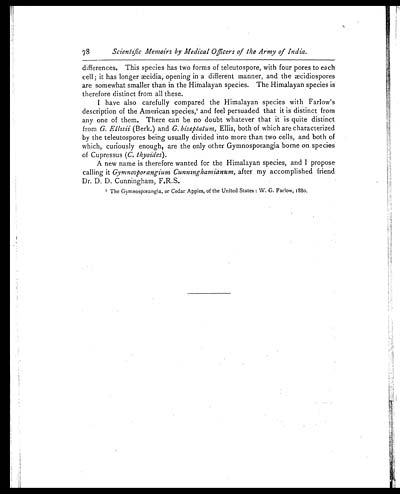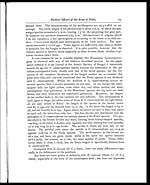Medicine - Institutions > Army health reports and medical documents > Scientific memoirs by medical officers of the Army of India > Part V, 1890 > 4 - On the life-history of a Himalayan Gymnosporangium (G. Cunninghamianum, Nov. Sp.)
(88) Page 78
Thumbnail gallery: Grid view | List view

78
Scientific Memoirs by Medical Officers of the Army of India.
differences. This species has two forms of teleutospore, with four pores to each
cell; it has longer æcidia, opening in a different manner, and the æcidiospores
are somewhat smaller than in the Himalayan species. The Himalayan species is
therefore distinct from all these.
I have also carefully compared the Himalayan species with Farlow's
description of the American species,1and feel persuaded that it is distinct from
any one of them. There can be no doubt whatever that it is quite distinct
fromG. Ellisii (Berk.) andG. biseptatum, Ellis, both of which are characterized
by the teleutospores being usually divided into more than two cells, and both of
which, curiously enough, are the only other Gymnosporangia borne on species
of Cupressus (C. thyoides ).
A new name is therefore wanted for the Himalayan species, and I propose
calling itGymnosporangium Cunning hamianum, after my accomplished friend
Dr. D. D. Cunningham, F.R.S.
1The Gymnosporangia, or Cedar Apples, of the United States: W. G. Farlow, 1880.
Set display mode to: Large image | Zoom image | Transcription
Images and transcriptions on this page, including medium image downloads, may be used under the Creative Commons Attribution 4.0 International Licence unless otherwise stated. ![]()
| Permanent URL | https://digital.nls.uk/75000512 |
|---|
| Shelfmark | IP/QB.10 |
|---|---|
| Additional NLS resources: | |




